Regent Street Restaurants: Monopolistic Competition, Costs and Profits
VerifiedAdded on 2023/06/17
|10
|2662
|431
Report
AI Summary
This report analyzes the monopolistic competition present in Regent Street, Central London, focusing on the restaurant and cafe market. It explores the characteristics of this market, including product differentiation, numerous suppliers, and ease of entry and exit. The report details how competitors differentiate themselves through unique offerings, quality, and marketing strategies, rather than price. It examines cost and profit management, explaining how firms aim to maximize profit by equating marginal revenue and marginal cost, achieving zero economic profit in the long run due to market entry. The document also compares marketing strategies, highlighting the importance of product differentiation and advertising. Finally, it contrasts monopolistic competition with perfect competition, oligopoly, and monopoly using a market structure typology matrix, focusing on the number of firms, product characteristics, barriers to entry, and price control. Desklib provides similar solved assignments for students.
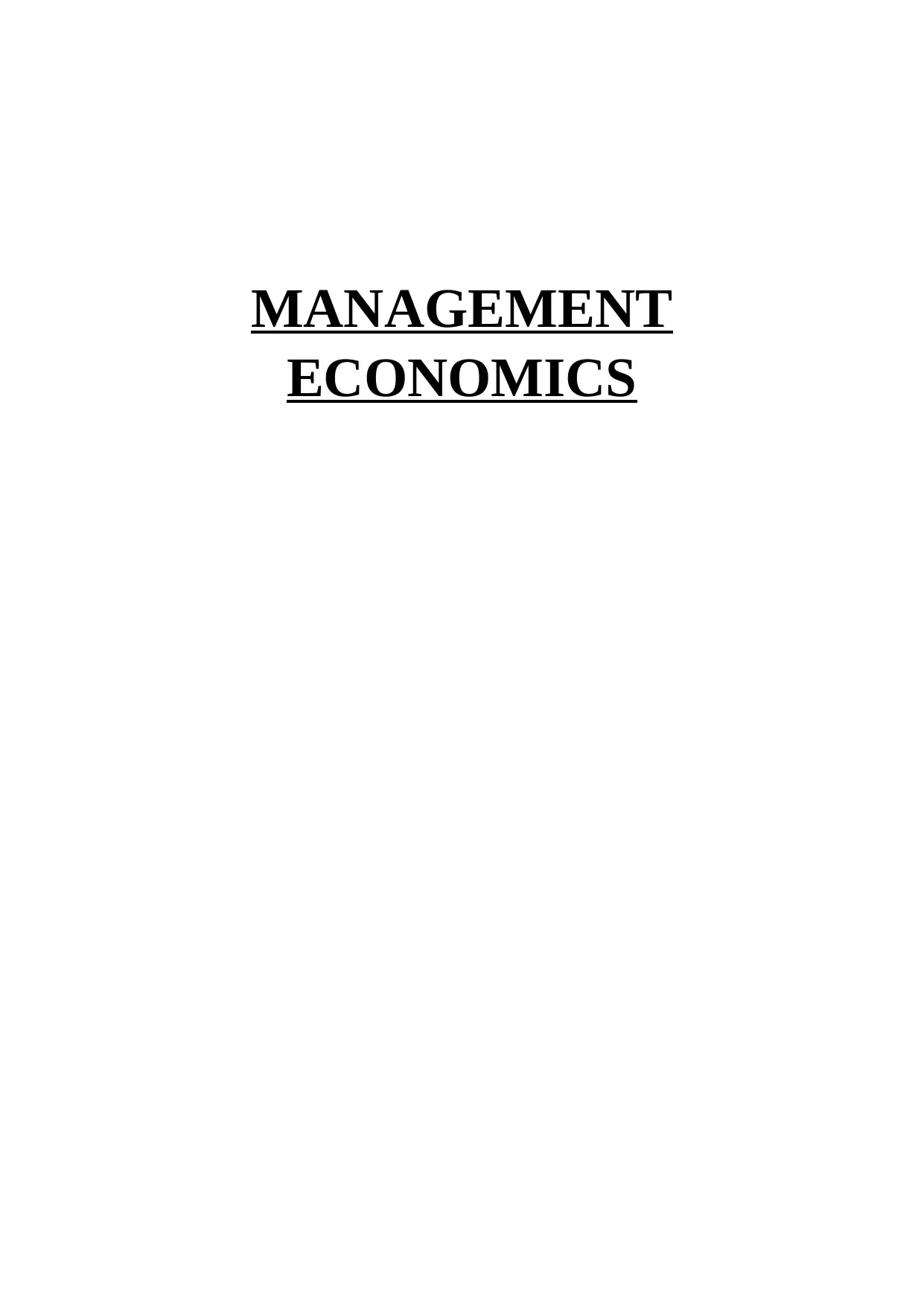
MANAGEMENT
ECONOMICS
ECONOMICS
Paraphrase This Document
Need a fresh take? Get an instant paraphrase of this document with our AI Paraphraser
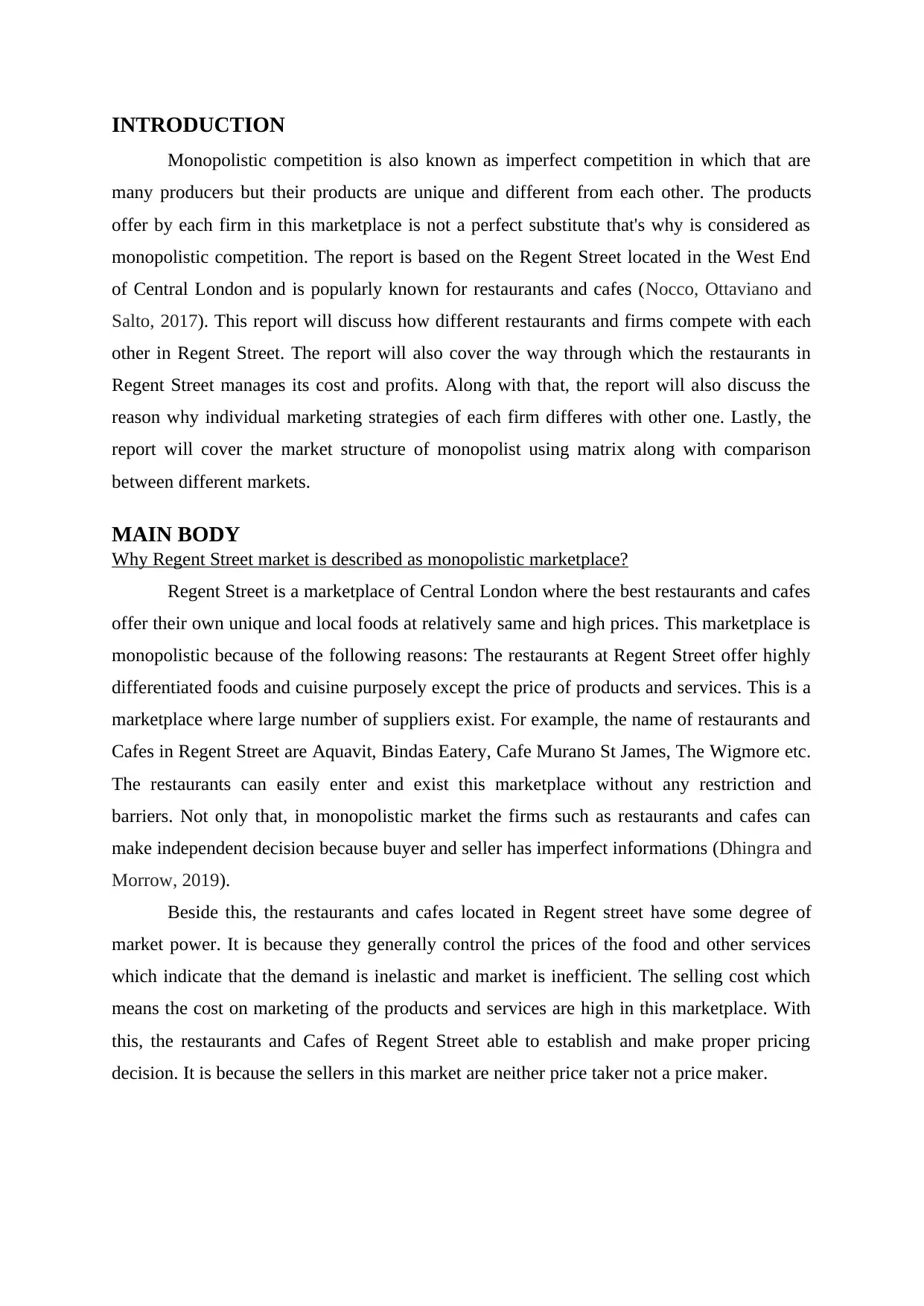
INTRODUCTION
Monopolistic competition is also known as imperfect competition in which that are
many producers but their products are unique and different from each other. The products
offer by each firm in this marketplace is not a perfect substitute that's why is considered as
monopolistic competition. The report is based on the Regent Street located in the West End
of Central London and is popularly known for restaurants and cafes (Nocco, Ottaviano and
Salto, 2017). This report will discuss how different restaurants and firms compete with each
other in Regent Street. The report will also cover the way through which the restaurants in
Regent Street manages its cost and profits. Along with that, the report will also discuss the
reason why individual marketing strategies of each firm differes with other one. Lastly, the
report will cover the market structure of monopolist using matrix along with comparison
between different markets.
MAIN BODY
Why Regent Street market is described as monopolistic marketplace?
Regent Street is a marketplace of Central London where the best restaurants and cafes
offer their own unique and local foods at relatively same and high prices. This marketplace is
monopolistic because of the following reasons: The restaurants at Regent Street offer highly
differentiated foods and cuisine purposely except the price of products and services. This is a
marketplace where large number of suppliers exist. For example, the name of restaurants and
Cafes in Regent Street are Aquavit, Bindas Eatery, Cafe Murano St James, The Wigmore etc.
The restaurants can easily enter and exist this marketplace without any restriction and
barriers. Not only that, in monopolistic market the firms such as restaurants and cafes can
make independent decision because buyer and seller has imperfect informations (Dhingra and
Morrow, 2019).
Beside this, the restaurants and cafes located in Regent street have some degree of
market power. It is because they generally control the prices of the food and other services
which indicate that the demand is inelastic and market is inefficient. The selling cost which
means the cost on marketing of the products and services are high in this marketplace. With
this, the restaurants and Cafes of Regent Street able to establish and make proper pricing
decision. It is because the sellers in this market are neither price taker not a price maker.
Monopolistic competition is also known as imperfect competition in which that are
many producers but their products are unique and different from each other. The products
offer by each firm in this marketplace is not a perfect substitute that's why is considered as
monopolistic competition. The report is based on the Regent Street located in the West End
of Central London and is popularly known for restaurants and cafes (Nocco, Ottaviano and
Salto, 2017). This report will discuss how different restaurants and firms compete with each
other in Regent Street. The report will also cover the way through which the restaurants in
Regent Street manages its cost and profits. Along with that, the report will also discuss the
reason why individual marketing strategies of each firm differes with other one. Lastly, the
report will cover the market structure of monopolist using matrix along with comparison
between different markets.
MAIN BODY
Why Regent Street market is described as monopolistic marketplace?
Regent Street is a marketplace of Central London where the best restaurants and cafes
offer their own unique and local foods at relatively same and high prices. This marketplace is
monopolistic because of the following reasons: The restaurants at Regent Street offer highly
differentiated foods and cuisine purposely except the price of products and services. This is a
marketplace where large number of suppliers exist. For example, the name of restaurants and
Cafes in Regent Street are Aquavit, Bindas Eatery, Cafe Murano St James, The Wigmore etc.
The restaurants can easily enter and exist this marketplace without any restriction and
barriers. Not only that, in monopolistic market the firms such as restaurants and cafes can
make independent decision because buyer and seller has imperfect informations (Dhingra and
Morrow, 2019).
Beside this, the restaurants and cafes located in Regent street have some degree of
market power. It is because they generally control the prices of the food and other services
which indicate that the demand is inelastic and market is inefficient. The selling cost which
means the cost on marketing of the products and services are high in this marketplace. With
this, the restaurants and Cafes of Regent Street able to establish and make proper pricing
decision. It is because the sellers in this market are neither price taker not a price maker.
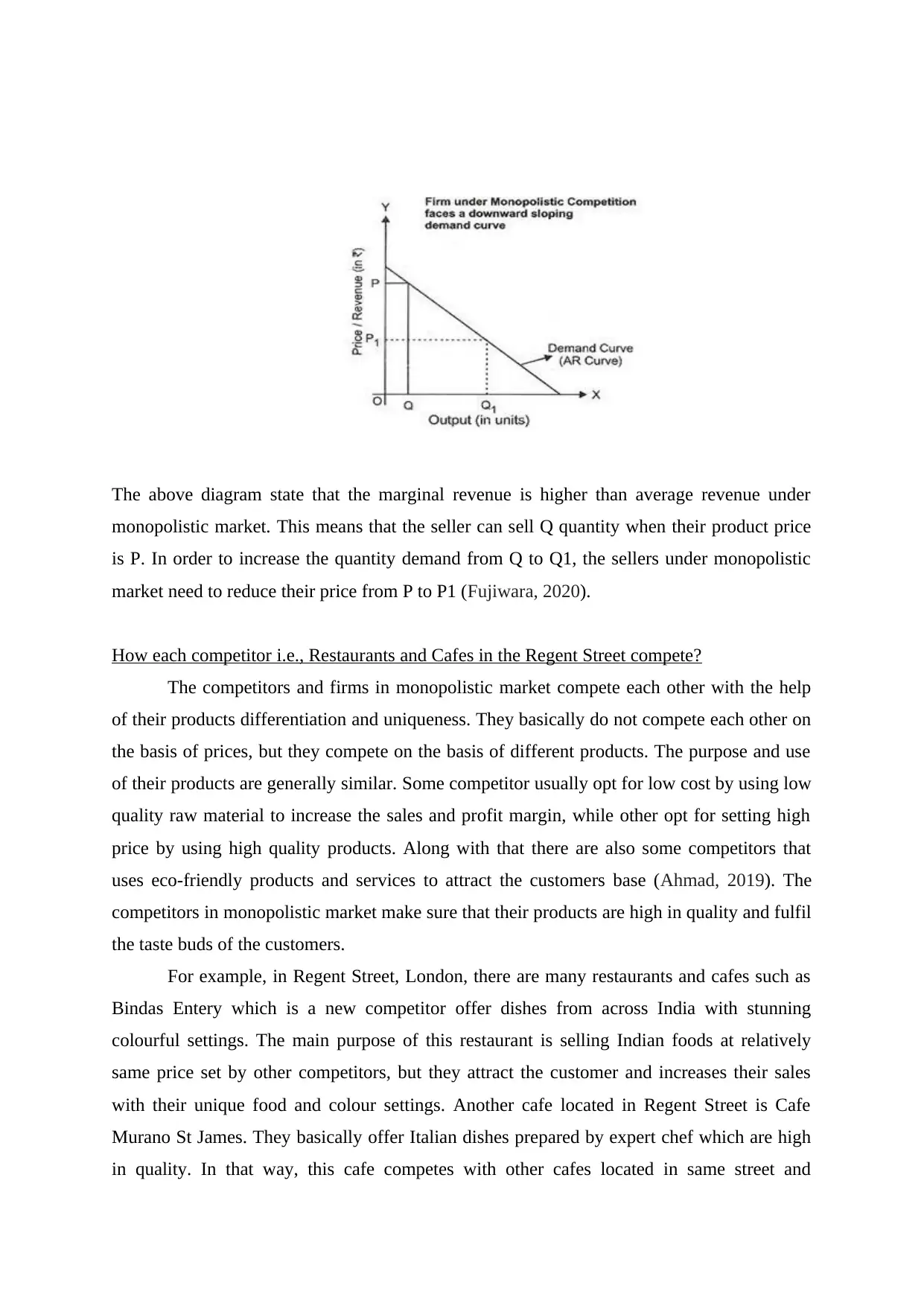
The above diagram state that the marginal revenue is higher than average revenue under
monopolistic market. This means that the seller can sell Q quantity when their product price
is P. In order to increase the quantity demand from Q to Q1, the sellers under monopolistic
market need to reduce their price from P to P1 (Fujiwara, 2020).
How each competitor i.e., Restaurants and Cafes in the Regent Street compete?
The competitors and firms in monopolistic market compete each other with the help
of their products differentiation and uniqueness. They basically do not compete each other on
the basis of prices, but they compete on the basis of different products. The purpose and use
of their products are generally similar. Some competitor usually opt for low cost by using low
quality raw material to increase the sales and profit margin, while other opt for setting high
price by using high quality products. Along with that there are also some competitors that
uses eco-friendly products and services to attract the customers base (Ahmad, 2019). The
competitors in monopolistic market make sure that their products are high in quality and fulfil
the taste buds of the customers.
For example, in Regent Street, London, there are many restaurants and cafes such as
Bindas Entery which is a new competitor offer dishes from across India with stunning
colourful settings. The main purpose of this restaurant is selling Indian foods at relatively
same price set by other competitors, but they attract the customer and increases their sales
with their unique food and colour settings. Another cafe located in Regent Street is Cafe
Murano St James. They basically offer Italian dishes prepared by expert chef which are high
in quality. In that way, this cafe competes with other cafes located in same street and
monopolistic market. This means that the seller can sell Q quantity when their product price
is P. In order to increase the quantity demand from Q to Q1, the sellers under monopolistic
market need to reduce their price from P to P1 (Fujiwara, 2020).
How each competitor i.e., Restaurants and Cafes in the Regent Street compete?
The competitors and firms in monopolistic market compete each other with the help
of their products differentiation and uniqueness. They basically do not compete each other on
the basis of prices, but they compete on the basis of different products. The purpose and use
of their products are generally similar. Some competitor usually opt for low cost by using low
quality raw material to increase the sales and profit margin, while other opt for setting high
price by using high quality products. Along with that there are also some competitors that
uses eco-friendly products and services to attract the customers base (Ahmad, 2019). The
competitors in monopolistic market make sure that their products are high in quality and fulfil
the taste buds of the customers.
For example, in Regent Street, London, there are many restaurants and cafes such as
Bindas Entery which is a new competitor offer dishes from across India with stunning
colourful settings. The main purpose of this restaurant is selling Indian foods at relatively
same price set by other competitors, but they attract the customer and increases their sales
with their unique food and colour settings. Another cafe located in Regent Street is Cafe
Murano St James. They basically offer Italian dishes prepared by expert chef which are high
in quality. In that way, this cafe competes with other cafes located in same street and
⊘ This is a preview!⊘
Do you want full access?
Subscribe today to unlock all pages.

Trusted by 1+ million students worldwide
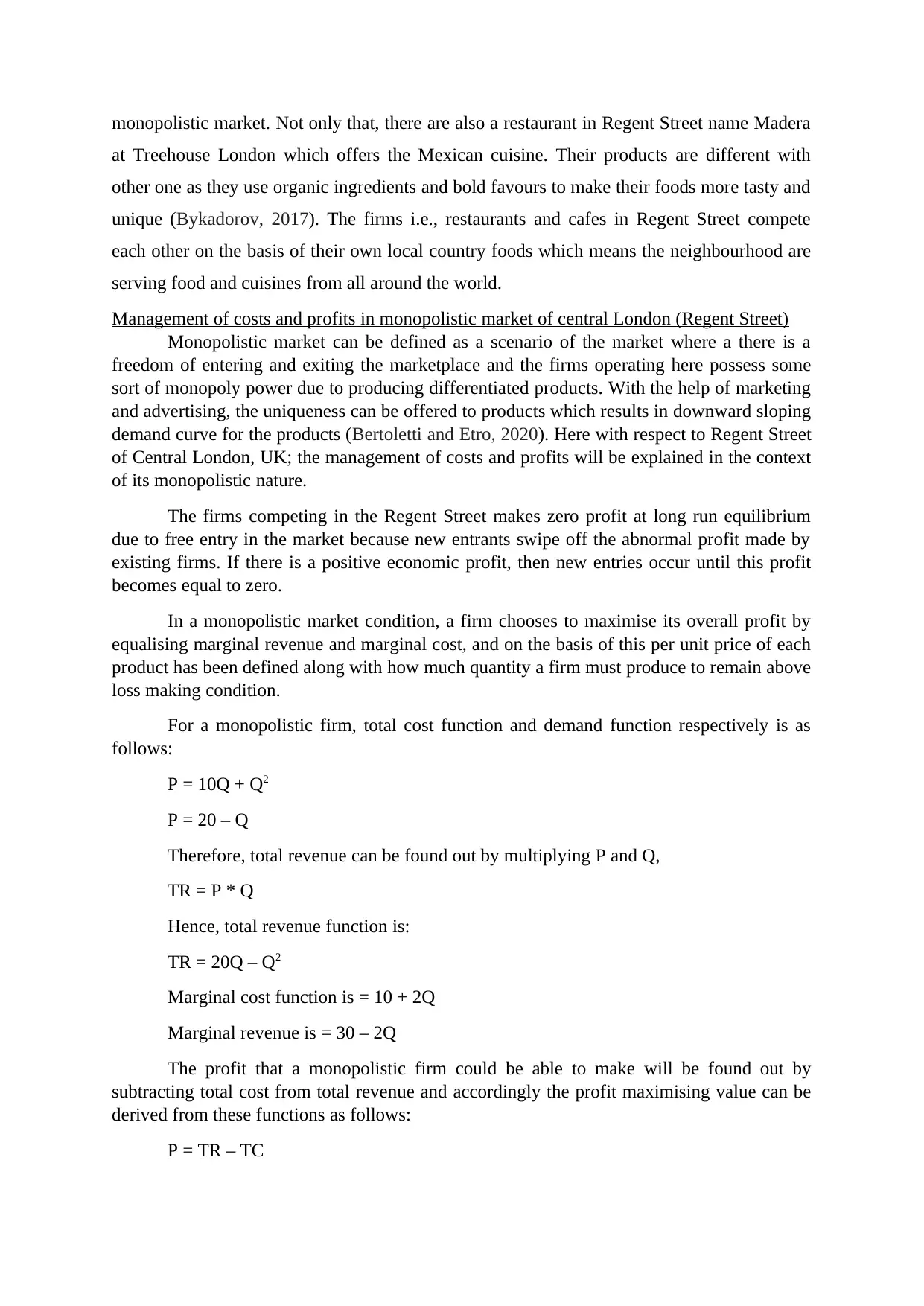
monopolistic market. Not only that, there are also a restaurant in Regent Street name Madera
at Treehouse London which offers the Mexican cuisine. Their products are different with
other one as they use organic ingredients and bold favours to make their foods more tasty and
unique (Bykadorov, 2017). The firms i.e., restaurants and cafes in Regent Street compete
each other on the basis of their own local country foods which means the neighbourhood are
serving food and cuisines from all around the world.
Management of costs and profits in monopolistic market of central London (Regent Street)
Monopolistic market can be defined as a scenario of the market where a there is a
freedom of entering and exiting the marketplace and the firms operating here possess some
sort of monopoly power due to producing differentiated products. With the help of marketing
and advertising, the uniqueness can be offered to products which results in downward sloping
demand curve for the products (Bertoletti and Etro, 2020). Here with respect to Regent Street
of Central London, UK; the management of costs and profits will be explained in the context
of its monopolistic nature.
The firms competing in the Regent Street makes zero profit at long run equilibrium
due to free entry in the market because new entrants swipe off the abnormal profit made by
existing firms. If there is a positive economic profit, then new entries occur until this profit
becomes equal to zero.
In a monopolistic market condition, a firm chooses to maximise its overall profit by
equalising marginal revenue and marginal cost, and on the basis of this per unit price of each
product has been defined along with how much quantity a firm must produce to remain above
loss making condition.
For a monopolistic firm, total cost function and demand function respectively is as
follows:
P = 10Q + Q2
P = 20 – Q
Therefore, total revenue can be found out by multiplying P and Q,
TR = P * Q
Hence, total revenue function is:
TR = 20Q – Q2
Marginal cost function is = 10 + 2Q
Marginal revenue is = 30 – 2Q
The profit that a monopolistic firm could be able to make will be found out by
subtracting total cost from total revenue and accordingly the profit maximising value can be
derived from these functions as follows:
P = TR – TC
at Treehouse London which offers the Mexican cuisine. Their products are different with
other one as they use organic ingredients and bold favours to make their foods more tasty and
unique (Bykadorov, 2017). The firms i.e., restaurants and cafes in Regent Street compete
each other on the basis of their own local country foods which means the neighbourhood are
serving food and cuisines from all around the world.
Management of costs and profits in monopolistic market of central London (Regent Street)
Monopolistic market can be defined as a scenario of the market where a there is a
freedom of entering and exiting the marketplace and the firms operating here possess some
sort of monopoly power due to producing differentiated products. With the help of marketing
and advertising, the uniqueness can be offered to products which results in downward sloping
demand curve for the products (Bertoletti and Etro, 2020). Here with respect to Regent Street
of Central London, UK; the management of costs and profits will be explained in the context
of its monopolistic nature.
The firms competing in the Regent Street makes zero profit at long run equilibrium
due to free entry in the market because new entrants swipe off the abnormal profit made by
existing firms. If there is a positive economic profit, then new entries occur until this profit
becomes equal to zero.
In a monopolistic market condition, a firm chooses to maximise its overall profit by
equalising marginal revenue and marginal cost, and on the basis of this per unit price of each
product has been defined along with how much quantity a firm must produce to remain above
loss making condition.
For a monopolistic firm, total cost function and demand function respectively is as
follows:
P = 10Q + Q2
P = 20 – Q
Therefore, total revenue can be found out by multiplying P and Q,
TR = P * Q
Hence, total revenue function is:
TR = 20Q – Q2
Marginal cost function is = 10 + 2Q
Marginal revenue is = 30 – 2Q
The profit that a monopolistic firm could be able to make will be found out by
subtracting total cost from total revenue and accordingly the profit maximising value can be
derived from these functions as follows:
P = TR – TC
Paraphrase This Document
Need a fresh take? Get an instant paraphrase of this document with our AI Paraphraser
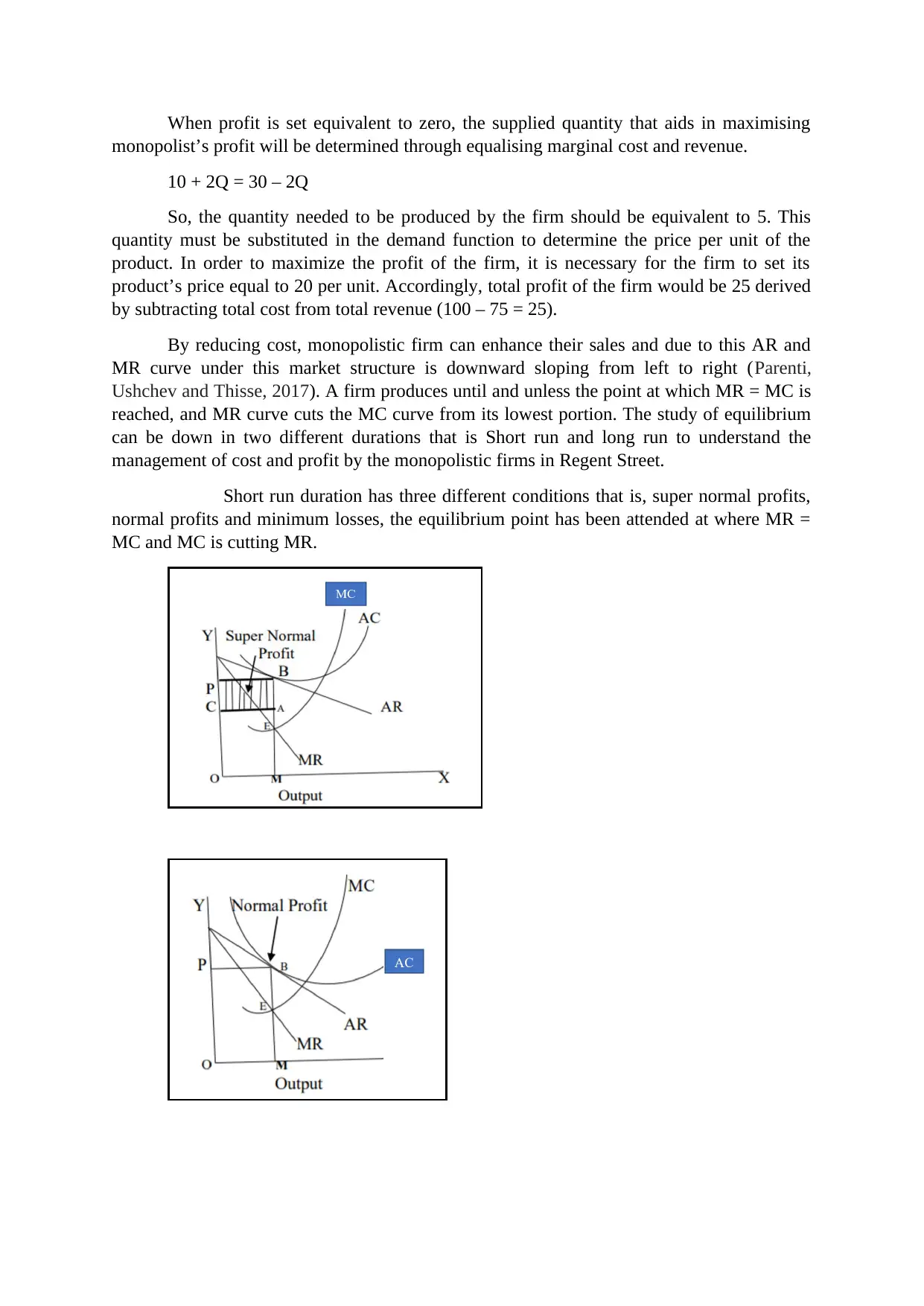
When profit is set equivalent to zero, the supplied quantity that aids in maximising
monopolist’s profit will be determined through equalising marginal cost and revenue.
10 + 2Q = 30 – 2Q
So, the quantity needed to be produced by the firm should be equivalent to 5. This
quantity must be substituted in the demand function to determine the price per unit of the
product. In order to maximize the profit of the firm, it is necessary for the firm to set its
product’s price equal to 20 per unit. Accordingly, total profit of the firm would be 25 derived
by subtracting total cost from total revenue (100 – 75 = 25).
By reducing cost, monopolistic firm can enhance their sales and due to this AR and
MR curve under this market structure is downward sloping from left to right (Parenti,
Ushchev and Thisse, 2017). A firm produces until and unless the point at which MR = MC is
reached, and MR curve cuts the MC curve from its lowest portion. The study of equilibrium
can be down in two different durations that is Short run and long run to understand the
management of cost and profit by the monopolistic firms in Regent Street.
Short run duration has three different conditions that is, super normal profits,
normal profits and minimum losses, the equilibrium point has been attended at where MR =
MC and MC is cutting MR.
monopolist’s profit will be determined through equalising marginal cost and revenue.
10 + 2Q = 30 – 2Q
So, the quantity needed to be produced by the firm should be equivalent to 5. This
quantity must be substituted in the demand function to determine the price per unit of the
product. In order to maximize the profit of the firm, it is necessary for the firm to set its
product’s price equal to 20 per unit. Accordingly, total profit of the firm would be 25 derived
by subtracting total cost from total revenue (100 – 75 = 25).
By reducing cost, monopolistic firm can enhance their sales and due to this AR and
MR curve under this market structure is downward sloping from left to right (Parenti,
Ushchev and Thisse, 2017). A firm produces until and unless the point at which MR = MC is
reached, and MR curve cuts the MC curve from its lowest portion. The study of equilibrium
can be down in two different durations that is Short run and long run to understand the
management of cost and profit by the monopolistic firms in Regent Street.
Short run duration has three different conditions that is, super normal profits,
normal profits and minimum losses, the equilibrium point has been attended at where MR =
MC and MC is cutting MR.
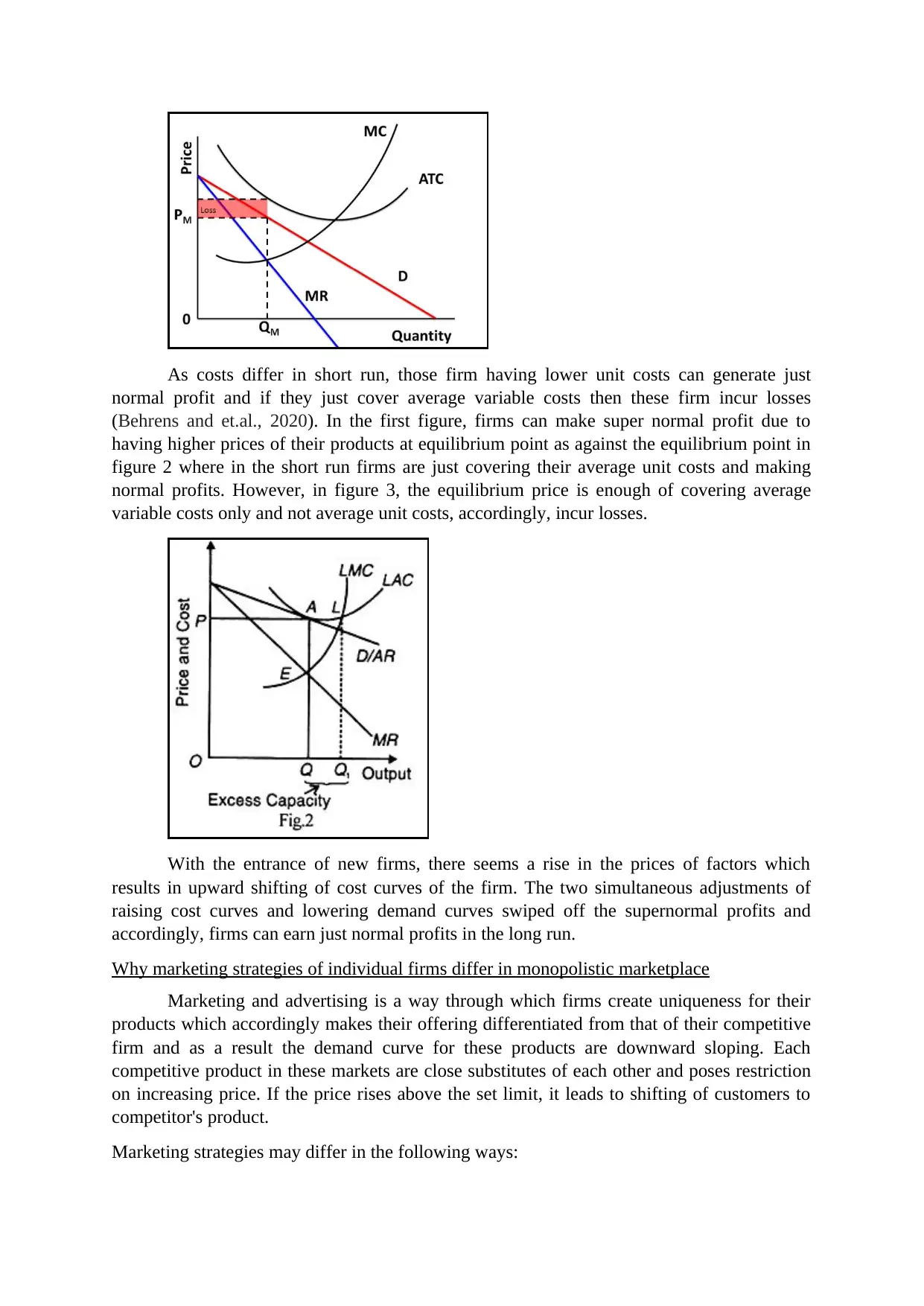
As costs differ in short run, those firm having lower unit costs can generate just
normal profit and if they just cover average variable costs then these firm incur losses
(Behrens and et.al., 2020). In the first figure, firms can make super normal profit due to
having higher prices of their products at equilibrium point as against the equilibrium point in
figure 2 where in the short run firms are just covering their average unit costs and making
normal profits. However, in figure 3, the equilibrium price is enough of covering average
variable costs only and not average unit costs, accordingly, incur losses.
With the entrance of new firms, there seems a rise in the prices of factors which
results in upward shifting of cost curves of the firm. The two simultaneous adjustments of
raising cost curves and lowering demand curves swiped off the supernormal profits and
accordingly, firms can earn just normal profits in the long run.
Why marketing strategies of individual firms differ in monopolistic marketplace
Marketing and advertising is a way through which firms create uniqueness for their
products which accordingly makes their offering differentiated from that of their competitive
firm and as a result the demand curve for these products are downward sloping. Each
competitive product in these markets are close substitutes of each other and poses restriction
on increasing price. If the price rises above the set limit, it leads to shifting of customers to
competitor's product.
Marketing strategies may differ in the following ways:
normal profit and if they just cover average variable costs then these firm incur losses
(Behrens and et.al., 2020). In the first figure, firms can make super normal profit due to
having higher prices of their products at equilibrium point as against the equilibrium point in
figure 2 where in the short run firms are just covering their average unit costs and making
normal profits. However, in figure 3, the equilibrium price is enough of covering average
variable costs only and not average unit costs, accordingly, incur losses.
With the entrance of new firms, there seems a rise in the prices of factors which
results in upward shifting of cost curves of the firm. The two simultaneous adjustments of
raising cost curves and lowering demand curves swiped off the supernormal profits and
accordingly, firms can earn just normal profits in the long run.
Why marketing strategies of individual firms differ in monopolistic marketplace
Marketing and advertising is a way through which firms create uniqueness for their
products which accordingly makes their offering differentiated from that of their competitive
firm and as a result the demand curve for these products are downward sloping. Each
competitive product in these markets are close substitutes of each other and poses restriction
on increasing price. If the price rises above the set limit, it leads to shifting of customers to
competitor's product.
Marketing strategies may differ in the following ways:
⊘ This is a preview!⊘
Do you want full access?
Subscribe today to unlock all pages.

Trusted by 1+ million students worldwide
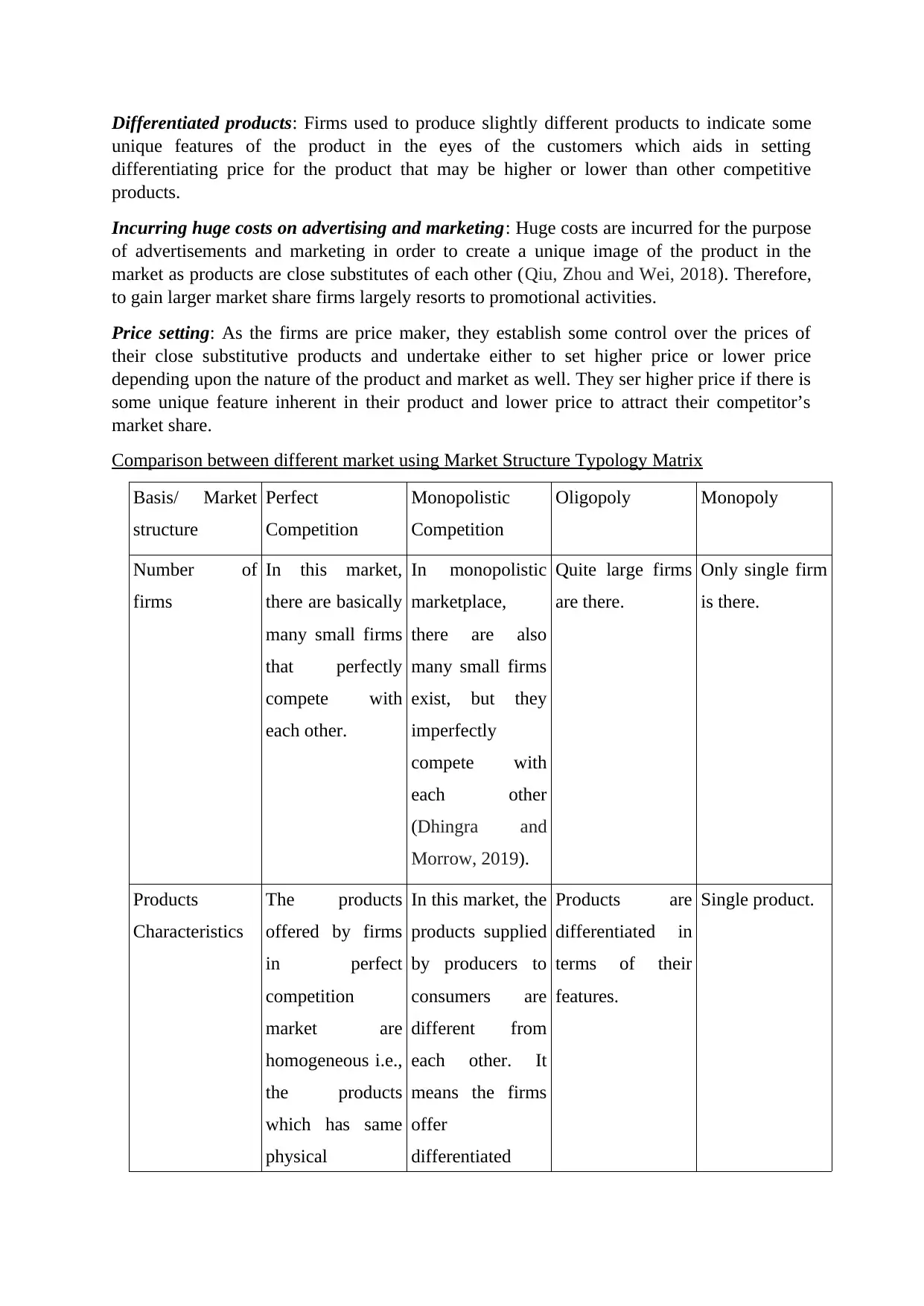
Differentiated products: Firms used to produce slightly different products to indicate some
unique features of the product in the eyes of the customers which aids in setting
differentiating price for the product that may be higher or lower than other competitive
products.
Incurring huge costs on advertising and marketing: Huge costs are incurred for the purpose
of advertisements and marketing in order to create a unique image of the product in the
market as products are close substitutes of each other (Qiu, Zhou and Wei, 2018). Therefore,
to gain larger market share firms largely resorts to promotional activities.
Price setting: As the firms are price maker, they establish some control over the prices of
their close substitutive products and undertake either to set higher price or lower price
depending upon the nature of the product and market as well. They ser higher price if there is
some unique feature inherent in their product and lower price to attract their competitor’s
market share.
Comparison between different market using Market Structure Typology Matrix
Basis/ Market
structure
Perfect
Competition
Monopolistic
Competition
Oligopoly Monopoly
Number of
firms
In this market,
there are basically
many small firms
that perfectly
compete with
each other.
In monopolistic
marketplace,
there are also
many small firms
exist, but they
imperfectly
compete with
each other
(Dhingra and
Morrow, 2019).
Quite large firms
are there.
Only single firm
is there.
Products
Characteristics
The products
offered by firms
in perfect
competition
market are
homogeneous i.e.,
the products
which has same
physical
In this market, the
products supplied
by producers to
consumers are
different from
each other. It
means the firms
offer
differentiated
Products are
differentiated in
terms of their
features.
Single product.
unique features of the product in the eyes of the customers which aids in setting
differentiating price for the product that may be higher or lower than other competitive
products.
Incurring huge costs on advertising and marketing: Huge costs are incurred for the purpose
of advertisements and marketing in order to create a unique image of the product in the
market as products are close substitutes of each other (Qiu, Zhou and Wei, 2018). Therefore,
to gain larger market share firms largely resorts to promotional activities.
Price setting: As the firms are price maker, they establish some control over the prices of
their close substitutive products and undertake either to set higher price or lower price
depending upon the nature of the product and market as well. They ser higher price if there is
some unique feature inherent in their product and lower price to attract their competitor’s
market share.
Comparison between different market using Market Structure Typology Matrix
Basis/ Market
structure
Perfect
Competition
Monopolistic
Competition
Oligopoly Monopoly
Number of
firms
In this market,
there are basically
many small firms
that perfectly
compete with
each other.
In monopolistic
marketplace,
there are also
many small firms
exist, but they
imperfectly
compete with
each other
(Dhingra and
Morrow, 2019).
Quite large firms
are there.
Only single firm
is there.
Products
Characteristics
The products
offered by firms
in perfect
competition
market are
homogeneous i.e.,
the products
which has same
physical
In this market, the
products supplied
by producers to
consumers are
different from
each other. It
means the firms
offer
differentiated
Products are
differentiated in
terms of their
features.
Single product.
Paraphrase This Document
Need a fresh take? Get an instant paraphrase of this document with our AI Paraphraser
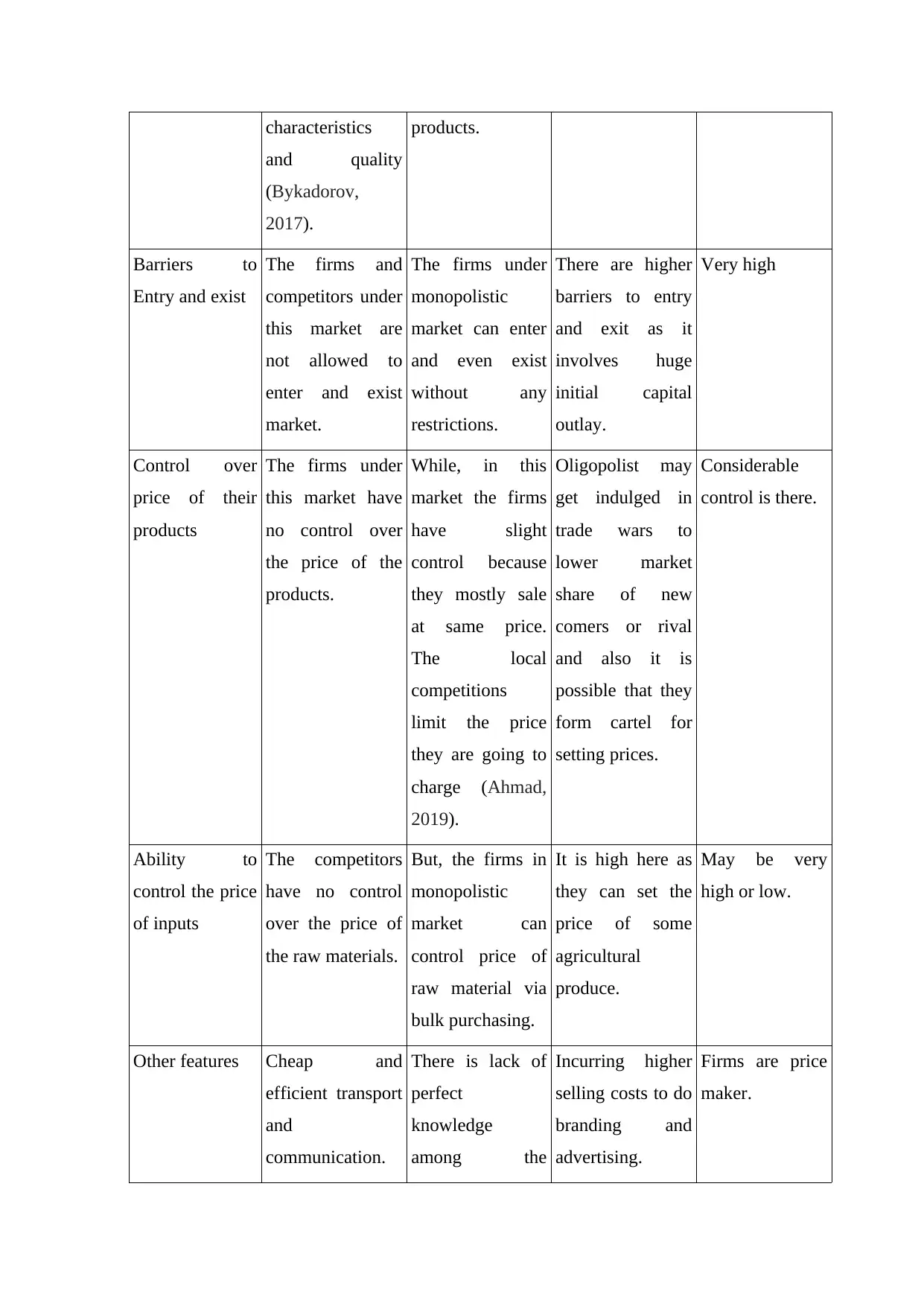
characteristics
and quality
(Bykadorov,
2017).
products.
Barriers to
Entry and exist
The firms and
competitors under
this market are
not allowed to
enter and exist
market.
The firms under
monopolistic
market can enter
and even exist
without any
restrictions.
There are higher
barriers to entry
and exit as it
involves huge
initial capital
outlay.
Very high
Control over
price of their
products
The firms under
this market have
no control over
the price of the
products.
While, in this
market the firms
have slight
control because
they mostly sale
at same price.
The local
competitions
limit the price
they are going to
charge (Ahmad,
2019).
Oligopolist may
get indulged in
trade wars to
lower market
share of new
comers or rival
and also it is
possible that they
form cartel for
setting prices.
Considerable
control is there.
Ability to
control the price
of inputs
The competitors
have no control
over the price of
the raw materials.
But, the firms in
monopolistic
market can
control price of
raw material via
bulk purchasing.
It is high here as
they can set the
price of some
agricultural
produce.
May be very
high or low.
Other features Cheap and
efficient transport
and
communication.
There is lack of
perfect
knowledge
among the
Incurring higher
selling costs to do
branding and
advertising.
Firms are price
maker.
and quality
(Bykadorov,
2017).
products.
Barriers to
Entry and exist
The firms and
competitors under
this market are
not allowed to
enter and exist
market.
The firms under
monopolistic
market can enter
and even exist
without any
restrictions.
There are higher
barriers to entry
and exit as it
involves huge
initial capital
outlay.
Very high
Control over
price of their
products
The firms under
this market have
no control over
the price of the
products.
While, in this
market the firms
have slight
control because
they mostly sale
at same price.
The local
competitions
limit the price
they are going to
charge (Ahmad,
2019).
Oligopolist may
get indulged in
trade wars to
lower market
share of new
comers or rival
and also it is
possible that they
form cartel for
setting prices.
Considerable
control is there.
Ability to
control the price
of inputs
The competitors
have no control
over the price of
the raw materials.
But, the firms in
monopolistic
market can
control price of
raw material via
bulk purchasing.
It is high here as
they can set the
price of some
agricultural
produce.
May be very
high or low.
Other features Cheap and
efficient transport
and
communication.
There is lack of
perfect
knowledge
among the
Incurring higher
selling costs to do
branding and
advertising.
Firms are price
maker.
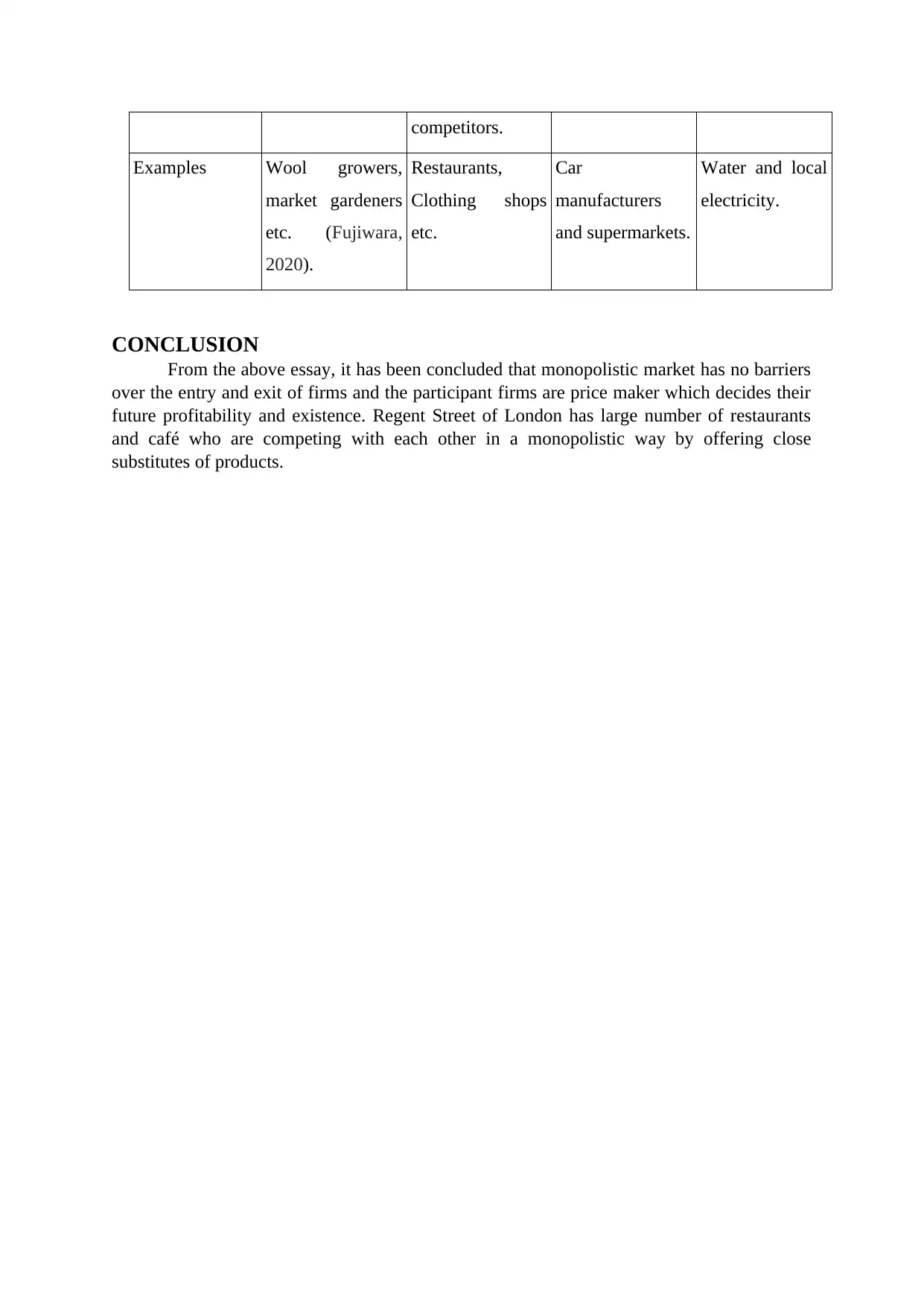
competitors.
Examples Wool growers,
market gardeners
etc. (Fujiwara,
2020).
Restaurants,
Clothing shops
etc.
Car
manufacturers
and supermarkets.
Water and local
electricity.
CONCLUSION
From the above essay, it has been concluded that monopolistic market has no barriers
over the entry and exit of firms and the participant firms are price maker which decides their
future profitability and existence. Regent Street of London has large number of restaurants
and café who are competing with each other in a monopolistic way by offering close
substitutes of products.
Examples Wool growers,
market gardeners
etc. (Fujiwara,
2020).
Restaurants,
Clothing shops
etc.
Car
manufacturers
and supermarkets.
Water and local
electricity.
CONCLUSION
From the above essay, it has been concluded that monopolistic market has no barriers
over the entry and exit of firms and the participant firms are price maker which decides their
future profitability and existence. Regent Street of London has large number of restaurants
and café who are competing with each other in a monopolistic way by offering close
substitutes of products.
⊘ This is a preview!⊘
Do you want full access?
Subscribe today to unlock all pages.

Trusted by 1+ million students worldwide
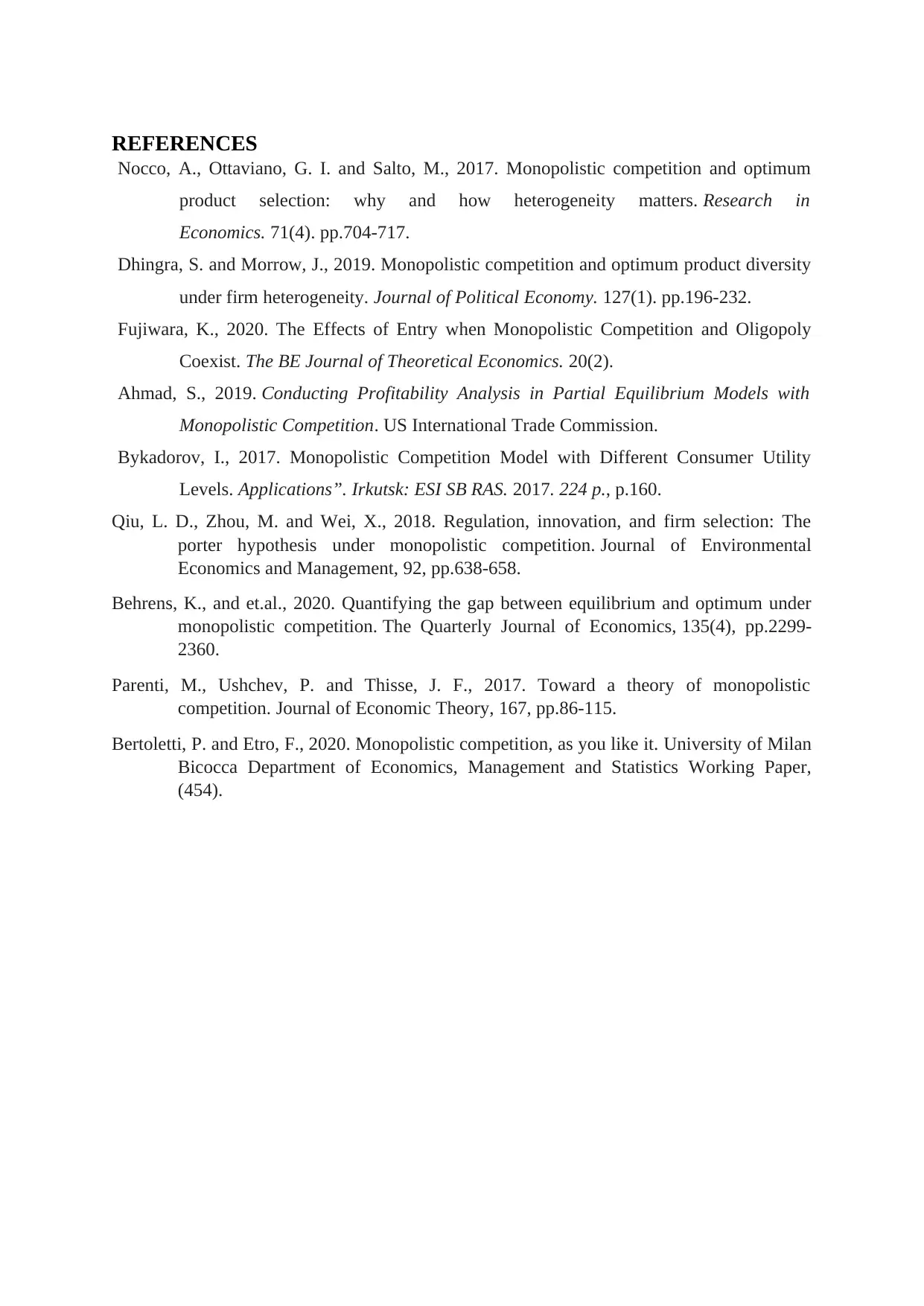
REFERENCES
Nocco, A., Ottaviano, G. I. and Salto, M., 2017. Monopolistic competition and optimum
product selection: why and how heterogeneity matters. Research in
Economics. 71(4). pp.704-717.
Dhingra, S. and Morrow, J., 2019. Monopolistic competition and optimum product diversity
under firm heterogeneity. Journal of Political Economy. 127(1). pp.196-232.
Fujiwara, K., 2020. The Effects of Entry when Monopolistic Competition and Oligopoly
Coexist. The BE Journal of Theoretical Economics. 20(2).
Ahmad, S., 2019. Conducting Profitability Analysis in Partial Equilibrium Models with
Monopolistic Competition. US International Trade Commission.
Bykadorov, I., 2017. Monopolistic Competition Model with Different Consumer Utility
Levels. Applications”. Irkutsk: ESI SB RAS. 2017. 224 p., p.160.
Qiu, L. D., Zhou, M. and Wei, X., 2018. Regulation, innovation, and firm selection: The
porter hypothesis under monopolistic competition. Journal of Environmental
Economics and Management, 92, pp.638-658.
Behrens, K., and et.al., 2020. Quantifying the gap between equilibrium and optimum under
monopolistic competition. The Quarterly Journal of Economics, 135(4), pp.2299-
2360.
Parenti, M., Ushchev, P. and Thisse, J. F., 2017. Toward a theory of monopolistic
competition. Journal of Economic Theory, 167, pp.86-115.
Bertoletti, P. and Etro, F., 2020. Monopolistic competition, as you like it. University of Milan
Bicocca Department of Economics, Management and Statistics Working Paper,
(454).
Nocco, A., Ottaviano, G. I. and Salto, M., 2017. Monopolistic competition and optimum
product selection: why and how heterogeneity matters. Research in
Economics. 71(4). pp.704-717.
Dhingra, S. and Morrow, J., 2019. Monopolistic competition and optimum product diversity
under firm heterogeneity. Journal of Political Economy. 127(1). pp.196-232.
Fujiwara, K., 2020. The Effects of Entry when Monopolistic Competition and Oligopoly
Coexist. The BE Journal of Theoretical Economics. 20(2).
Ahmad, S., 2019. Conducting Profitability Analysis in Partial Equilibrium Models with
Monopolistic Competition. US International Trade Commission.
Bykadorov, I., 2017. Monopolistic Competition Model with Different Consumer Utility
Levels. Applications”. Irkutsk: ESI SB RAS. 2017. 224 p., p.160.
Qiu, L. D., Zhou, M. and Wei, X., 2018. Regulation, innovation, and firm selection: The
porter hypothesis under monopolistic competition. Journal of Environmental
Economics and Management, 92, pp.638-658.
Behrens, K., and et.al., 2020. Quantifying the gap between equilibrium and optimum under
monopolistic competition. The Quarterly Journal of Economics, 135(4), pp.2299-
2360.
Parenti, M., Ushchev, P. and Thisse, J. F., 2017. Toward a theory of monopolistic
competition. Journal of Economic Theory, 167, pp.86-115.
Bertoletti, P. and Etro, F., 2020. Monopolistic competition, as you like it. University of Milan
Bicocca Department of Economics, Management and Statistics Working Paper,
(454).
1 out of 10
Related Documents
Your All-in-One AI-Powered Toolkit for Academic Success.
+13062052269
info@desklib.com
Available 24*7 on WhatsApp / Email
![[object Object]](/_next/static/media/star-bottom.7253800d.svg)
Unlock your academic potential
Copyright © 2020–2025 A2Z Services. All Rights Reserved. Developed and managed by ZUCOL.





